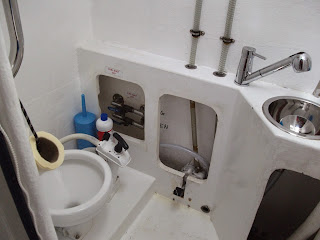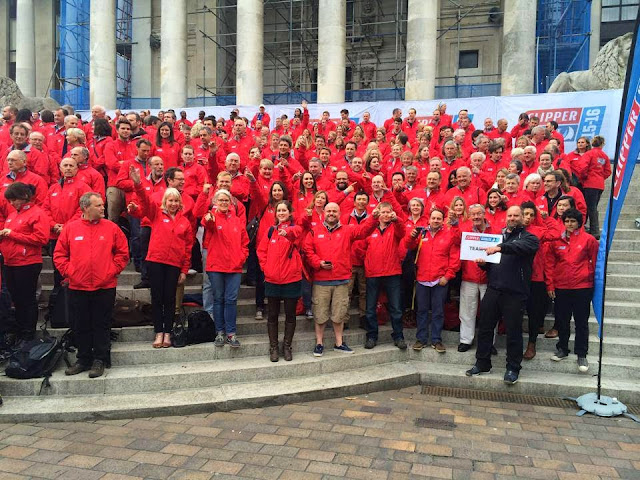The idea of Level 2 training is to get an understanding of what it is like living on board 24/7 in a watch system - cooking, cleaning, sailing, sleeping, engine checking, sleeping, being seasick, helming, sleeping, nausea ......... etc.
The day after Crew Allocation I reported to a school swimming pool in Gosport where 20 of us were doing our sea survival training. We spent the morning going through the theory of surviving if tossed overboard, abandoning into a life raft or staying with the boat. A charismatic guy brought life to what could have been a very boring session but turned out to be quite interesting, before we all headed for the swimming pool to put into practice some of the things we had talked about in the morning. We jumped into the pool, clambered into a life raft, formed a 'snake' to get from one end of the pool to the other, raced, shouted, swam, had buckets of water thrown at us - simulation of the Pacific Ocean I think, and generally had a laugh. A good way to start to get to know the crew we would be spending the next few days with.
 |
| 'The Crew' |
It was then onto the boat, CV9, with nine others plus skipper and mate, for the sailing part of the training. The crew was an eclectic mix of Chinese, French, South Africans, Dutch and a smattering of Brits, which made for some interesting discussions and cultural exchanges. Most of us succumbed to a bout of seasickness with some of the younger South Africans taking to their bunks for a significant part of the time. Considering some of them couldn't swim and had probably never seen the sea before they generally made a stirling effort to take part.
 |
| Sunset over the Isle of Wight from the English Channel |
The idea was to head west down towards Portland but the exceptionally cold wind for the time of year, from the north and west, meant that we headed south across the Channel to France instead. We witnessed a couple of stunning sunsets, one across to the Isle of Wight and the other as we headed towards the French coast, which made the crossing bearable.
 |
Evening sky as we head towards the French coast east of the
Cherbourg Peninsular |
It was lovely watching the sky get darker and for the moon to rise into a star studded sky, while the lights on fishing boats, tankers and cruise liners blinked and sparkled across the black sea. To say that I am excited about crossing some of the most inhospitable oceans in the world is an understatement. I can't wait to experience the night skies and sunsets, to watch the changing colour of the sea as day turns to night and back again, to see the sun set and moon rise, though not necessarily in that order, and to experience the sounds of the water as we slice our way from one continent to another.

What was it like living on board? For the first two and a half days I was feeling nauseous and was sea sick. I did wonder what on earth I had signed up for and was I making an enormous mistake. Kees (pronounced Case), our skipper, took part in the 13-14 race and tried to convince us that the nauseous feeling goes after 2-3 days as the body starts to ignore the sensations created by the fluids in the inner ear. Unfortunately we didn't stay offshore for more than 2 1/2 days so his theory was never fully tested. I did manage to get out of my bunk and onto deck for my watches, but because I didn't eat properly for 48 hours I started to feel very weak, tired and dizzy. Kees made the decision to go back to Gosport as, at times, there weren't enough crew on deck to practice sail changes, reefing etc. A good decision though I would have like to have stayed out for a further 24 hours. We had fulfilled the brief - got a good idea of what it was like to live offshore and to function within a watch system.
 |
Is anything vertical? The cooker certainly doesn't
seem to think so. |
We all took it in turns to be on Mother Watch - to cook and clean - and it was an interesting experience heating up baked beans and pasties while the boat tacked from side to side. The cooker was on gimbals but never seemed to sit in an horizontal position - or perhaps I was never in a vertical position to judge. I would be leaning one way only to find that my world tipped and I was then leaning the other.
Getting in and out of my bunk was challenging, as was going to the loo. If there was a clatter up above it probably meant we were about to tack so 'brace..brace..brace' as the boat rocked through 90 degrees. Sleeping wasn't too bad and I managed to get to sleep quite quickly. There was the 'snoring orchestra' in concert most nights but the sound of the water on the hull as the boat travelled through the water was loud, but comforting at the same time. The boat slamming into the waves wasn't too much of a problem for me but then I have had many years of training as I slept in large dormitories in various boarding schools as I grew up.
 |
| The view behind |
Our last day of training was spent sailing up and down the Solent practicing the evolutions we hadn't been able to do during the preceding days due to low watch numbers. Tacking, gybing, putting in reefs, shaking out reefs, man over board drills, lowering and raising headsails, driving, knot tying practice, were all gone through in fine detail until we had it sussed. I have to say, training is hard work, especially when it is cold.
 |
| Sunset over the Solent |
I was sad to be returning to Gosport at the end of our last day of sailing. I know I hadn't been well for part of the time but I had met some wonderful people from all over the world. I have now met someone who will book me a hotel room and show me round Quindao when I get there in March 2016. I have cooked and cleaned with young South Africans who are about to embark on their journeys of a lifetime as they are each sponsored for one leg of the race. I have heard and taken onboard advice given by the skipper who took part in the race a couple of years ago and I have learned a little more about living and sailing on an ocean racing yacht.
 |
| The deep clean of floor boards |
The last morning was spent deep cleaning the boat. This involves cleaning everything from the bilges to the galley and heads, from the mattresses and cushions to the floor boards. I was on floor boards which entailed taking all the boards off the boat, washing both tops and underneaths with Milton, drying them and trying to put them back in the same order and place they came out from. Luckily some of the younger guys had technical backgrounds so could solve the puzzle as they were presented with various unlabelled floor boards through various hatches in what seemed like a random order.
On reflection it was a good week, though at times I did wonder if I had done the right thing in signing up as I leant over the guard rail on the leeward side at the back of the boat. Now that I am back home I know it is the right thing to be doing.
My Level 3 starts next week on the 15th May with an Offshore Safety course, before we head out into the Solent again. This time it will be on one of the 70 ft race boats so that we can practice with the asymmetric spinnaker and start thinking about race tactics. I can't wait!!

















